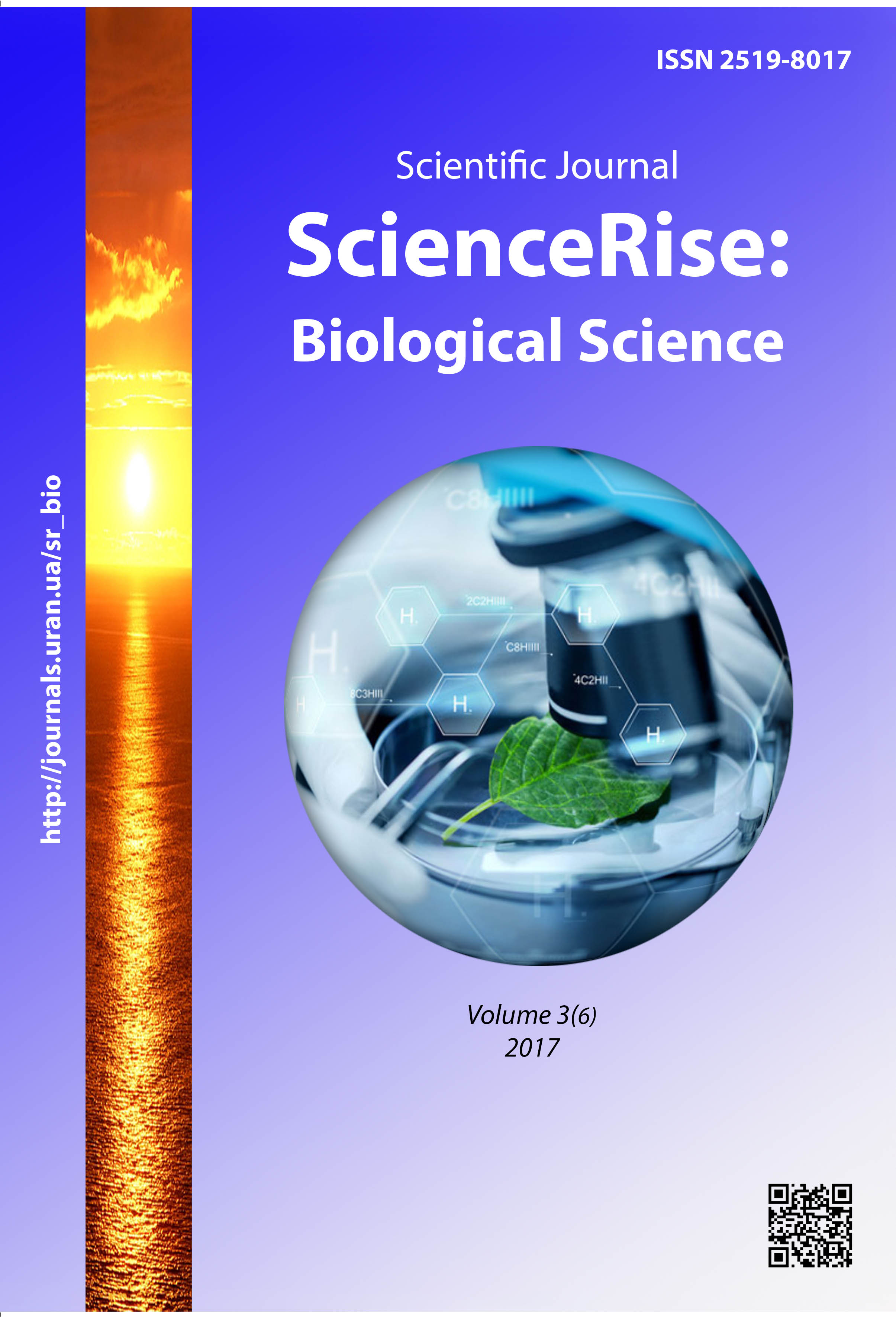Analysis of psamophytic complex of the national park "Biloberezhzhya Svyatoslava"
DOI:
https://doi.org/10.15587/2519-8025.2017.105277Keywords:
psamophytic complex, National natural park, anthropogenic transformation, kenophytization, archeophytization indicesAbstract
Aim of research – the comprehensive analysis of the complicated psamophytic complex of the national park “Biloberezhzhya Svyatoslava”.
Object of research – types of the psamophytic complex of the national park “Biloberezhzhya Svyatoslava”.
The following tasks were set for attaining this aim:
– to study: the geographical structure: by zonal, regional and oceanic horologic groups;
– biomorphological structure: by the big life cycle duration, by the root system type, by surface sprouts type, by vegetation type;
– ecological structure: climamorphes, geliomorphes, hygromorphes, thermomorphes;
– to elucidate features of the direction and anthropogenic transformation degree of the psamophytic ecocenophyton of the national natural park “Biloberezhzhya Svyatoslava”.
Methods. The material was collections of psamophytic plants of flora of the national natural park “Biloberezhzhya Svyatoslava”, revealed at detail-route investigations. There were used cameral methods – herbaria material processing and mathematical statistics methods. To reveal ecophytons’ similar features there was realized the comparison of the taxonomic compositions of studied territories by the Stugren-Radolescu coefficient.
For the detail study of features of psamophytic ecocenophyton anthropogenic transformation were used indices (parameters), offered by B. Jackowiak in 1990 that indicate the percent participation of groups by their relation to antropopression in flora or its separate elements.
Results and conclusions. In the systematic spectrum the psamophytic florocomplex is characterized by the essential heterogeneity in both family and generic spectrums.
In the geographical spectrum in the zonal spectrum prevails the submeridional horologic group, in the regional spectrum – ancient Mediterranean, Eurasian and circumpolar, in the oceanic spectrum – indifferent one.
The feature of the psamophyton biomorphological structure is the prevalence of herbal monocarpic plants by the big life cycle duration, types with the core root system – by the root system type, semi-rosette and non-rosette – by surface sprouts type, summer green species – by vegetation type.
In the psamophyton ecological structure prevailed: by climatomophes– terrophytes and hemicryprophytes, by geliomorphes – gelophytes, by hygromorphes – xeromesophytes and mesopytes, by thermomorphes – mesothermophytes.
Almost all indices, except PS, CS, Pap, Fap, PapS that indicate the degree and direction of anthropogenic transformation of the psamophytic complex of studied flora are essentially lower than correspondent parameters for other psamophytic complexes and protected territories in whole. But they were higher than ones for the national natural park “Biloberezhzhya Svyatoslava” flora in general. Apophytization prevails over anthropophytization in the process of flora synantropization.
The relatively high synantropization index proves that the psamophytic complex of the national natural park “Biloberezhzhya Svyatoslava” flora belongs to territories with the high degree of anthropogenic of flora. The high indices of anthropophytization, kenophytization and modernization, apophytization of the flora psamophytic complex comparing with other territories determines the synantropization specificity of the psamophytic complex of the national natural park “Biloberezhzhya Svyatoslava” flora that is in the prevalence of apophytization process over adventization
References
- Gilyarov, M. S. (Ed.) (1986). Biologicheskiy entseklopedicheskiy slovar. Moscow: Sovetskaya entsiklopediya, 892.
- Dіduh, Ya. P., Kovtun, I. V. (2004). Teoretichnі aspekti vidіlennya tsenoflori. Y. K. Pachoskiy ta suchasna botanіka. Kherson: Aylant, 98–101.
- Derkach, O. M., Taraschuk, S. V. (1994). Naukove obgruntuvannya stvorennya regionalnogo landshaftnogo parku «Kinburnska kosa». Proekt stvorennya RLP «Kinburnska kosa». Mykolayiv: TOV «Oykumena», 21.
- Kolomiets, G. V. (2008). Kinburn: perspektivi zbalansovanogo rozvitku. Seriya: Zberezhennya bioriznomanittya v Primorsko-stepovomu ekokoridori. Kyiv: Gromadska organizatsIya «Sribna chayka», 48.
- Melnik, R. P. (2009). Invaziya Amorpha fruticosa L. v tsenozah urochischa «Komendantske». V botanichni chitannya pam’yati Y. K. Pachoskogo». Kherson, 124.
- Umanets, O. Iu. (1997). Ekoloho-tsenotychnakharakterytyka flory pishchanykh masyviv Livoberezhzhia Nyzhnoho Dnipra ta yii henezys. Kyiv, 19.
- Onyshchenko, V. A., Andriienko, T. L. (Eds.) (2012). Fitoriznomanittia zapovidnykiv i natsionalnykh pryrodnykh parkiv Ukrainy. Natsionalni pryrodni parky. P. 2. Kyiv: Fitosotsiotsentr, 580.
- Mirkin, B. M., Naumova, L. G., Solomets, A. I. (2001). Sovremennaya nauka o rastitelnosti. Moscow: Logos, 264.
- Jackowiak, B. (1990). Antropogeniczne przemiany flory roslin naczyniowych Poznania. UAM Poznan, S. Biologia, 42, 1–232.
- Melnik, R. P. (2001). Urbanoflora Mikolaeva. Kherson, 370.
- Melnychuk, S. S. (2006). Flora Matviivskoho pishchanoho masyvu. Studentskyi naukovyi visnyk Mykolaivskoho derzhavnoho universytetu imeni V.O. Sukhomlynskoho, 1, 53–54.
- Moysienko, I. I. (1999). Urbanoflora Hersona. Yalta, 190.
Downloads
Published
How to Cite
Issue
Section
License
Copyright (c) 2017 Svetlana Melnychuk, Ganna Trochymenko

This work is licensed under a Creative Commons Attribution 4.0 International License.
Our journal abides by the Creative Commons CC BY copyright rights and permissions for open access journals.
Authors, who are published in this journal, agree to the following conditions:
1. The authors reserve the right to authorship of the work and pass the first publication right of this work to the journal under the terms of a Creative Commons CC BY, which allows others to freely distribute the published research with the obligatory reference to the authors of the original work and the first publication of the work in this journal.
2. The authors have the right to conclude separate supplement agreements that relate to non-exclusive work distribution in the form in which it has been published by the journal (for example, to upload the work to the online storage of the journal or publish it as part of a monograph), provided that the reference to the first publication of the work in this journal is included.









